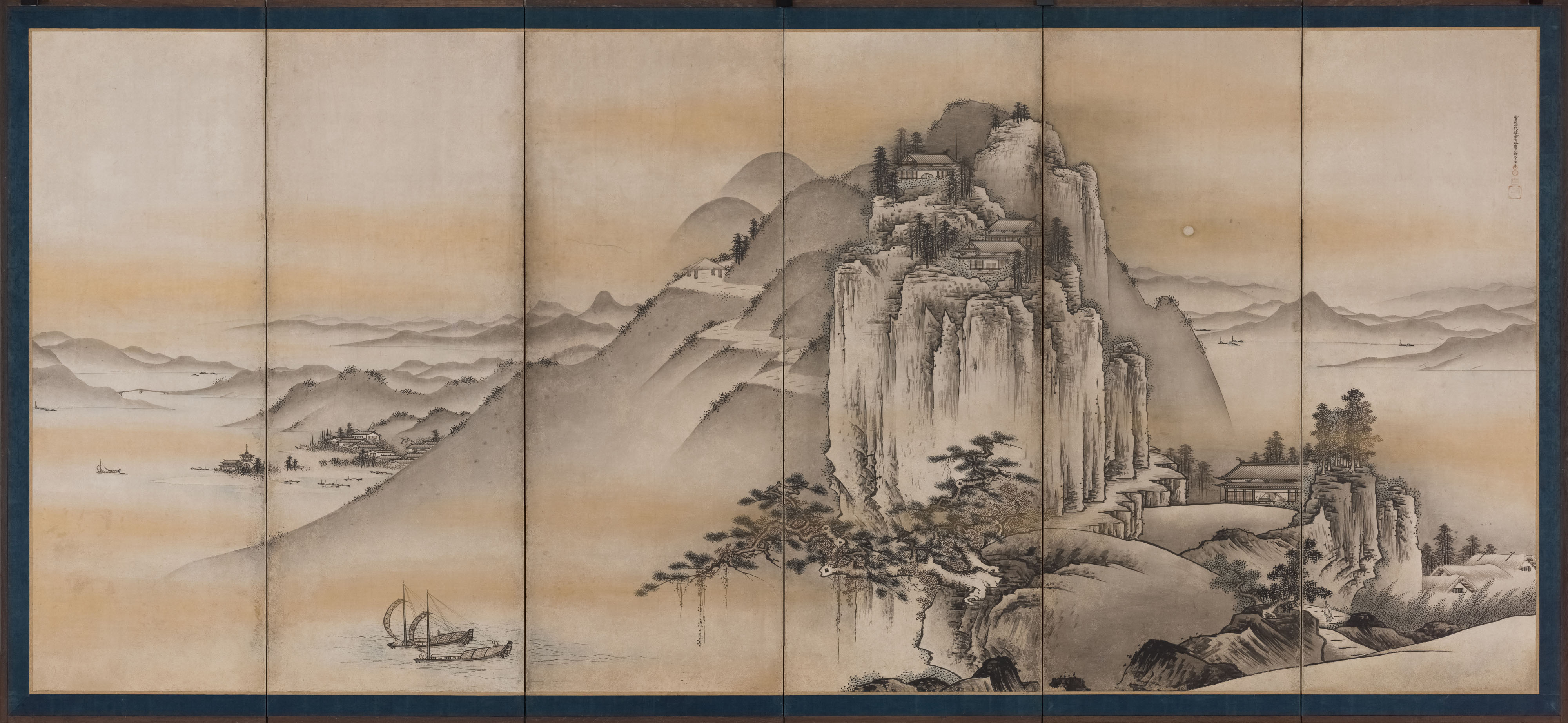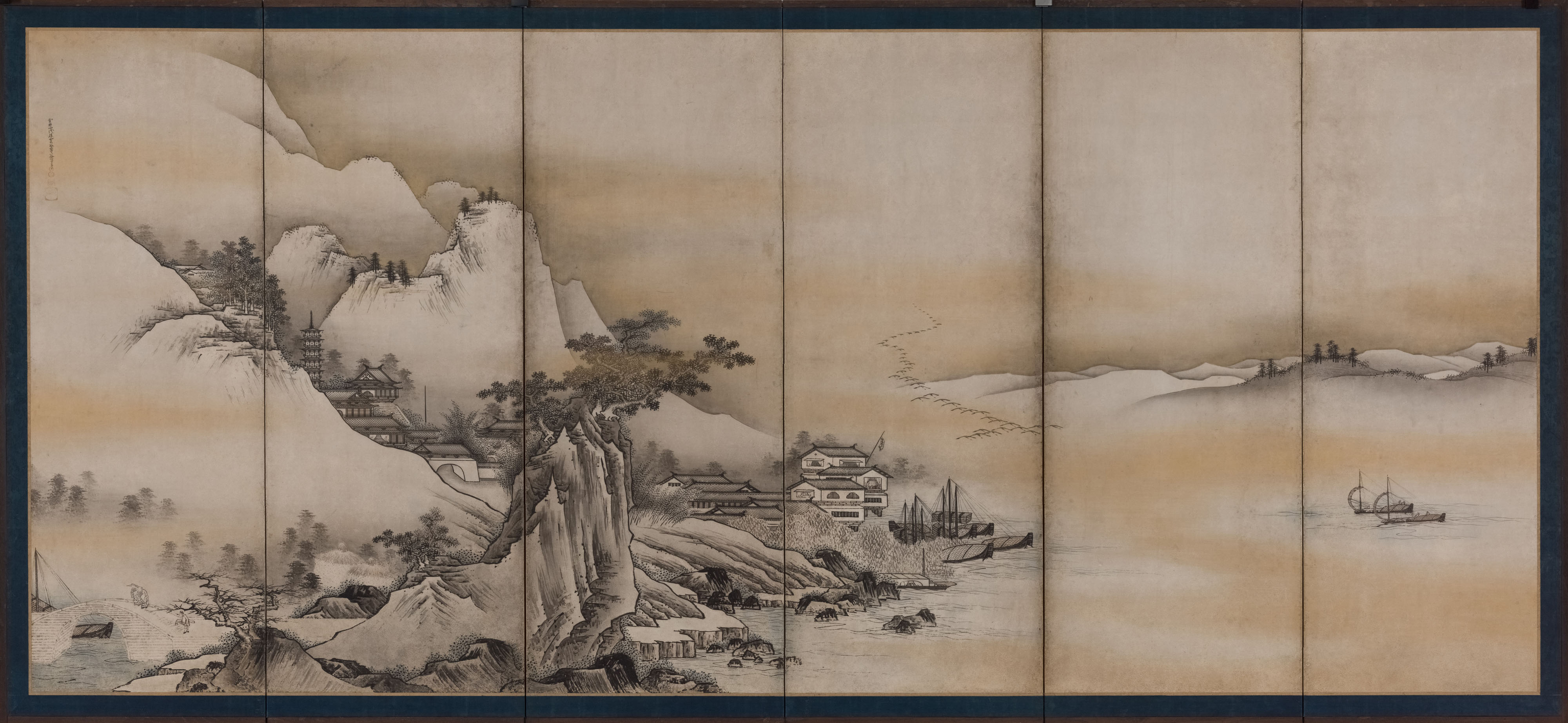
しょうしょうはっけいず 瀟湘八景図
不詳(江戸時代 17世紀)
紙本墨画淡彩金泥
雲谷派2代・等益による山水図屛風の代表作のひとつ。垂直と水平を意識した構図と、ジグザグに横に伸びる松の枝、丸い岩など幾何学的なモチーフの形が特徴的です。等益は個性が強い雪舟の画法を、雲谷派の画家たちが代々継承しやすいように、わかりやすく整理して、すっきりとした画面を作りました。父等顔の山水図と比べると、均一な墨のグラデーションが美しく、霞のように金泥(金色の絵の具)を薄く引くなど装飾的になっており、江戸時代初期の絵画に特有の明るさが感じられます。
瀟湘八景とは、中国湖南省の景勝地・洞庭湖(どうていこ)周辺の8つの景観のこと。例えば、平沙落雁(へいさらくがん)は「湖に雁の群れが降りてくる様子」、漁村夕照(ぎょそんせきしょう)は「夕暮れ時の漁村の風景」など、中国北宋時代11世紀に生まれた8つの画題は日本でも好まれました。本図にはその画題を示すモチーフや場面が描かれ、鑑賞者が八景を連想して楽しむゲームのような仕掛けが盛り込まれています。
雲谷等益【うんこく とうえき】
生没年 1591~1644(天正19年~天保元年)
雲谷等顔の次男として生まれ、兄等屋(とうおく)の早世により雲谷宗家を継ぎ、雲谷派2代目として「雪舟四代」を名乗りました。萩を拠点に京都・大徳寺内の諸塔頭(たっちゅう)の襖絵制作も行い、寛永3年(1626)法橋(ほっきょう)に叙任。雪舟の画法を流派の様式として整理し、雲谷派の流派体制を確立。江戸時代初期に特有の平明で整然とした作風が特徴です。
| 寸法 | [左]156.5×357.7/[右]156.4×357.4 cm |
|---|---|
| 形状 | 六曲屏風 |

Eight Views of the Xiao and Xiang Rivers
Ink, light color and gold paint on paper
This work is one of the most important landscape folding scrolls created by Toeki, the second leader of the Unkoku School. Characteristic of this picture are the composition, in which the focus is placed upon the contrast between horizontal and vertical orientation on the screens and the geometrical forms of motifs such as zigzagging pine branches extending horizontally, and round rocks. Toeki reorganized Sesshu’s idiosyncratic style of painting into an easy-to-understand one that painters of the Unkoku School found it simple to adopt in subsequent generations. He produced pictures with a clear-cut composition. Compared with the landscapes by his father, Togan, this one by Toeki offers the brightness that is peculiar to the pictures created during the early Edo period. This quality is thanks to its decorative manner, including the beautiful gradations of ink and thin lines of gold paint drawn to resemble haze.
Shosho hakkei refers to depictions of eight scenic spots near Lake Dongting in Hunan Province, China. In the 11th century, during the Northern Sung Dynasty, artistic themes were created involving these scenic spots and these eight themes, including Heisa Rakugan (Wild Geese Descending onto a Sandbar) and Gyoson Sekisho (A Fishing Village in the Glow of Sunset). These were later also depicted in many paintings in Japan. This work incorporates many motifs and scenes suggesting these eight themes. The viewer can enjoy associating them with Shosho hakkei as a kind of game.
Unkoku Toeki (1591 – 1644)
Toeki was the second son of Unkoku Togan. He became the head of the Unkoku family after his elder brother Tooku died at an early age. He took the name of Sesshu IV, as the 2nd leader of the Unkoku School. Although based in Hagi (the present-day Hagi City, Yamaguchi Prefecture), he was active in various other parts of the country, including Kyoto, where he produced fusuma-e (paintings on sliding doors) for minor temples in the
precincts of the Daitoku-ji Temple. He became hokkyo (the third highest rank in the hierarchy of Buddhist monks) in 1626. He reorganized the painting techniques of Sesshu to create his own school’s style, solidifying the foundation of the Unkoku School. His painting style is characterized by its clear-cut and orderly representation expression characteristic of the early Edo period.
| Size | 156.5×357.7/156.4×357.4 cm |
|---|

瀟湘八景圖
雲穀派第2代——等益的山水圖屏風的代表作之一。其特征在於,垂直與水平的構圖意識,之字形橫向延伸的鬆枝,圓形岩石等幾何形狀。等益將個性強烈的雪舟畫風,整理得簡單易懂,便於雲穀派畫家們代代傳承,創作了幹淨的畫麵。與父親等顏的山水圖相比,美麗均勻的墨色漸變,如同晚霞般,加有一層薄薄的金漆(金色的顏料)來裝飾,能感受到江戶時代初期繪畫特有的明亮感。
瀟湘八景是指中國湖南省風景名勝區洞庭湖周邊的八處景觀。例如,平沙落雁是“雁群落湖的樣子”,漁村夕照是“黃昏時的漁村風景”等,誕生於中國北宋時期11世紀的8個畫題,在日本也很受歡迎。本圖描繪了表現主題的場麵,像小遊戲一般,讓觀者以此去聯想八景。
雲穀 等益
生卒年 1591~1644(天正19年~正保元年)
生為雲穀等顏的次子,兄長等屋早逝後,作為第2代雲穀派繼承了雲穀本家,號稱“雪舟四代”。以萩市為據點,繪製京都大德寺內諸塔頭的隔扇畫,寬永3年(1626年)繼任法橋僧位。將雪舟畫法整理為流派式樣,確立了雲穀派的流派體製。江戶初期特有的簡明有序的畫風是其特征。
| 尺寸 | 156.5×357.7/156.4×357.4 cm |
|---|

소상팔경도
이 작품은 운코쿠파 제2대 당주 도에키가 그린 산수도 병풍 대표작 중 하나입니다. 수직과 수평을 의식한 구도와, 지그재그로 옆으로 자라는 소나무의 가지, 둥그런 바위 등 기하학적인 모티브의 모양이 특징입니다. 도에키는 개성이 강한 셋슈의 화법을 운코쿠파의 화가들이 대대로 계승할 수 있도록 알기 쉽게 정리하여 깔끔한 화폭을 만들어 내었습니다. 아버지 도간의 산수도와 비교하면 먹으로 만든 균일한 그라데이션이 아름답고, 봄 안개를 그려내 듯 금니(금색의 물감)를 옅게 칠하는 등 장식적인 요소가 보이며, 에도시대 초기 회화에서 볼 수 있는 특유의 밝음이 느껴집니다.
소상팔경이란, 중국 후난성의 경승지 둥팅호 주변의 여덟 개의 경관을 뜻합니다. 예를 들어 평사낙안은 「호수에 기러기 떼가 내려앉는 모습」, 어촌석조는 「해질녘 어촌의 풍경」 등, 중국 북송 시대 11세기에 생긴 여덟 개의 그림 주제는 일본에서도 인기였습니다. 본 작품에는 그 그림 주제를 나타내는 모티브나 장면이 그려져 있어, 감상자가 팔경을 연상하며 즐기는, 게임과 같은 장치가 담뿍 담겨있습니다.
운코쿠 도에키
생몰년 1591년 ~1644년 (덴쇼 19년 ~ 쇼호 원년)
운코쿠 도간의 차남으로 태어났으나 형 도오쿠의 요절로 인해 운코쿠 종가를 잇게 됩니다. 운코쿠파의 제2대 당주로서 「셋슈4대」를 위명한 그는, 하기를 거점으로 교토 다이토쿠지 절 안의 모든 탑두의 장벽화(후스마에)를 제작하였고, 1626년(간에이3년) 승려의 계급중 하나인 ‘법교(法橋)’에 서임합니다. 셋슈의 화법을 유파의 양식으로 정리하였고, 운코쿠파의 유파 제작을 확립시켰습니다. 에도시대 초기 특유의 단순하고 정연한 작풍이 특징입니다.
| 치수 | 156.5×357.7/156.4×357.4 cm |
|---|


